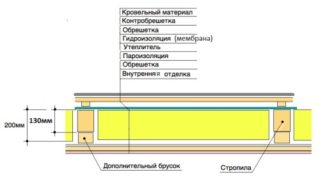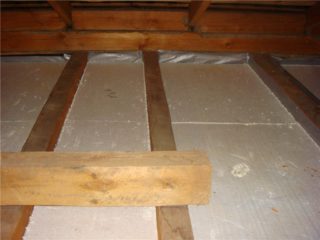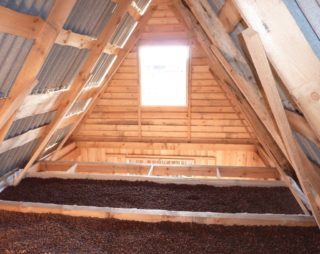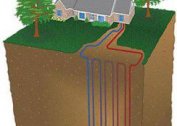Warming of the ceiling of a cold attic is an event that contributes to the creation of a comfortable microclimate on the top floor of a private house. The need to insulate the floor slab is justified by the law of physics, according to which warm air rises. After contact with a cold ceiling, it sinks down and cools the entire room. To prevent this from happening, an insulating barrier should be made between the ceiling and the attic. When choosing a material for warming a cold attic over floor slabs, it is necessary to pay attention to its qualities such as environmental and fire safety, biological and chemical inertness, low thermal conductivity and hygroscopicity, and a long service life. The requirements for thermal insulation are established by SNIP, and the laying rules are established by GOST. The standards are quite strict, but justified by safety criteria.
Insulation of the attic floor with mineral wool
Mineral wool has a long history of application and is very popular in private construction. The technology of production of mineral wool is constantly being improved, so that more and more high-quality products are at the disposal of consumers. The greatest demand is for TechnoNIKOL basalt cotton wool, which has better characteristics than slag and glass analogues.
Material Advantages:
- low thermal conductivity;
- almost unlimited service life;
- ecological cleanliness;
- high degree of sound insulation;
- ease of installation;
- incombustibility;
- flexibility and resilience;
- static form and volume.
Warming of the attic flooring on wooden beams with mineral wool should be carried out in closed clothing, means of protection of the organs of vision and breathing. The material releases tiny fibers into the air, causing acute irritation when it enters the body.
Since the slabs are soft, they are laid in a frame that serves as a support for the finishing or intermediate floor. Since the substance passes air well, moisture can accumulate in it coming from the lower rooms. To remove it, a vapor-permeable membrane is used.
The installation technology is as follows:
- A vapor-permeable film is laid on a wooden ceiling. It is better to fix it with a household stapler. The edges of the fabric must be brought to the walls at a level of 30 cm and also fixed.
- Making a frame from boards. The size of the lattice cells is selected according to the format of the material. Previously, the wood needs to be well dried, treated with an antiseptic and a flame retardant.
- Cutting the roll into fragments of the desired length. Placement of insulation in the frame. If gaps remain, they are sealed with foam.
- Nailing vapor-permeable fabric to the crate. The joints are sealed with tape.
- Laying the final or intermediate flooring.
Similarly, the roof attic is insulated. Plates are installed in the spacer between the rafters of the walls and the roof. In order for the insulation to fit tightly in niches, you need to make mesh 2-3 cm more plates. This will avoid the appearance of cracks.
It is necessary to remove the material from the packaging immediately before use so that it is not saturated with moisture.
Foam insulation
Polyfoam is a plate consisting of many porous balls. Manufacturers produce products with a size of 100 × 100 cm, a thickness of 50 mm and 100 mm. Since the material does not allow air to pass through, it is used to equip concrete structures, concrete basements and other structures equipped with forced ventilation.
Advantages of expanded polystyrene:
- low density;
- ease;
- water tightness;
- resistance to fungus and mold;
- simplicity of cutting and installation;
- durability;
- environmental Safety;
- affordable cost;
- lack of need for use of vapor-permeable fabrics and additional isolation.
The technology of laying the insulation on the attic reinforced concrete floor:
- Cleaning the plate from protruding fragments, sealing cracks and holes. If necessary, alignment with a solution is carried out.
- Primer surface treatment. Drawing a layer of liquid waterproofing.
- If the attic floor will be subjected to regular vertical loads, a diagram is drawn up and a crate is made with a mesh of 100 × 100 cm, a height of 5 cm or 10 cm.
- Foam plates are laid directly on the floor or in the frame. When placed on concrete, glue is used, and the slabs are staggered. During the installation of the gap, you need to blow out the foam.
- Fastens the flooring. The choice can be made in favor of boards, OSB boards or laminated panels.
To avoid squeaks, it is necessary to lay the substrate on the insulation, and only then lay the finish coating.
Use of sawdust as a heater
Sawdust is rarely used to equip the attic of a bathhouse and a private house, since you can find more effective and durable factory-made materials. But with a limited construction estimate, a decision is made to insulate the structure with sawdust.
This substance has the following advantages:
- woodworking waste is worth nothing;
- ecological purity of natural raw materials;
- vapor permeability;
- low specific gravity;
- ease of installation.
Among the disadvantages include high hygroscopicity and a tendency to rot with the formation of high humidity.
Attic insulation on floor slabs is carried out in this way:
- Sawdust is well dried, treated with an antiseptic and hydrophobic agent. Then the raw material is again well dried.
- The surface of the attic floor is lined with a vapor barrier. Its edges from all sides rise to Mauerlat by 20-30 cm.
- A clay, gypsum or alabaster mortar is mixed in a concrete mixer.
- Sawdust is poured into the container and mixed with the base for 3-4 minutes, after which the mixture is poured onto the ceiling. The solution is carefully leveled using a level and a wide spatula.
- After complete drying, the insulated floor is covered with cracks. They are covered with a mixture of clay and sand. After that, the surface is ground, dust and debris are removed from it.
- The vapor-permeable web is being laid. The edges of the second layer are connected to the edges of the fabric laid at the first stage of arrangement. It is advisable to choose a dense film that will serve as a substrate.
In the attic, you can lay any topcoat resistant to humidity and temperature extremes. Here it is necessary to make the right choice so that at the end of the winter you do not have to redo the work.
Expanded clay insulation
This insulation for floors is made from a mixture based on clay by vulcanization. The result of the process is rounded granules. To improve the sorbing properties and compaction of the mixture, they are crushed.
Material Advantages:
- affordable cost;
- low thermal conductivity;
- ease of use;
- light weight;
- ecological cleanliness;
- incombustibility.
Among the disadvantages include shrinkage of the layer under its own weight and high hygroscopicity. If you choose expanded clay, every 3-4 years this insulation of the floor will have to be replaced.
Instructions for thermal insulation of the attic with expanded clay:
- Laying on the basis of a double vapor barrier film. The joints between the strips are glued with tape.
- Production of skeleton boards with parameters corresponding to the finish coating.Before installation, the wood must be soaked with an antiseptic and drying oil.
- Mixing granules of small, medium and large fractions. Filling the mixture into the cells. Leveling the material. Another filling option is the manufacture of a solution of gypsum densely saturated with expanded clay. In this case, the crate can not be done, and pour the solution directly onto the film.
- Installation of the second line of wind protection. The edges of the film are damped to prevent the penetration of moisture from the outside.
- Laying the floor. Planks or plates lie on the frame. A monolithic surface can be covered with commercial linoleum.
In the same way, attic insulation is perlite. In its characteristics, it is not much superior to expanded clay, but has a higher cost.







